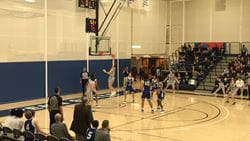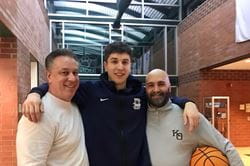Sam Petrarca of Venetia, Pa., is an athlete – a basketball player - so routine aches and pains aren’t unusual for him. In March 2020, after basketball season ended, Sam was feeling some minor back pain. He had joined a pickup basketball league with some high school kids. After those games, he would always have pain in the middle of the back. He’d ice it and his mom would massage it, neither of which helped. By the summer of that year, he tried a chiropractor, who lasered it and put e-stim to it, which actually worsened the pain.
Sam started his freshman year of college at Penn State Behrend in Erie, Pa. that August. One day he went to the gym to shoot hoops with a roommate, but was in so much pain he had to leave early. He went to the medical center at school, where the nurse thought she heard something in his chest – she suspected a spontaneous pneumothorax, which is the sudden onset of a collapsed lung without any apparent cause. Because his heart rate was elevated, he went to a local hospital in Erie for x-rays.
 Now back at home in Venetia, a local Pittsburgh hospital took more x-rays and a CT scan, suspecting it may be an ulcer. Now Sam’s pain was coming through his rib area too. At about the same time he got sick with COVID-19 and was coughing a lot.
Now back at home in Venetia, a local Pittsburgh hospital took more x-rays and a CT scan, suspecting it may be an ulcer. Now Sam’s pain was coming through his rib area too. At about the same time he got sick with COVID-19 and was coughing a lot.
They called Sam’s pediatrician. He was able to talk to the radiologist at the local hospital and then ordered an MRI. By the time the MRI was done in mid-September 2020, Sam was uncomfortable all the time. He was dragging one leg. He would lie on his belly on a beanbag chair as much as possible.
Pam talked to the pediatrician when the MRI results came in.
“The first thing he said was ‘Good news – it’s not cancer. Bad news – it’s serious. It’s an aneurysmal bone cyst.’ He knew of Dr. Stephanie Greene and said she’s the only one we should see,” says Pam.
An aneurysmal bone cyst is a benign but locally destructive lesion of the bone characterized by spongy cystic tissue filled with blood. It accounts for 2.5% of bone tumors.
The Neurovascular Center of Excellence
Dr. Greene leads the Neurovascular Center of Excellence at UPMC Children’s Hospital of Pittsburgh, a multidisciplinary center offering world-class care for children, teens, and adults up to age 23 who have conditions that affect the blood vessels in the brain and spine. The center’s surgical, imaging, and medical teams work together to ensure our patients receive the most cutting-edge, evidence-based care.
Imaging showed that the cyst was in the T9 vertebra, and Dr. Greene explained that Sam would need surgery to remove it and stabilize his spine. He was prescribed a medication called gabapentin preoperatively to help with his pain. A CT scan needed to be completed in preparation for surgery. And he needed to wait several weeks after his COVID infection, so that his lungs could tolerate the anesthesia necessary for surgery.
By early October when surgery was scheduled, Sam could not walk unassisted. He had begun losing his balance and stability in late September, which rapidly worsened.
On the day of surgery, Sam could barely get out of the car, but he refused to use a wheelchair – so Pam and Tony helped him through the parking garage at UPMC Children’s.
“He couldn’t walk on his heels. He walked on his toes,” says Tony.
Sam’s surgery was expected to take between four and five hours.
“We were the first ones in the waiting room,” says Pam. “And we were the last ones in the waiting room.”
In total, Sam’s time under anesthesia lasted seven and a half hours. Because of his rapid neurologic decline, the team was concerned about the stability of Sam’s spine, and it took about two hours just to position him on the operating table. The end result? The majority of Sam’s T9 vertebra was removed in order to remove the aneurysmal bone cyst, and a mesh cage was put in its place. Sam had two rods and nine screws installed to stabilize his spine.
Sam spent four days recovering on an inpatient unit at UPMC Children’s, where he did physical therapy every day, starting to lift his legs and walking again despite the drains he had in his body after surgery.
“It was good to know he was in such great hands,” say Pam and Tony. “Sam’s brother played high school football, and one of his games was televised. One nurse had played football at a local high school, and he sat in our room and watched the game with us. Everyone became so close with us.”
Sam was transferred to the Children’s Hospital Rehabilitation Unit (CHRU), the hospital’s inpatient rehabilitation unit, for further recovery and therapies. The oldest patient at the CHRU by far, the staff and Sam’s parents believed that he would make better progress at home, so he stayed in the rehab unit only two days. And he did make great progress at home. Sam withdrew from college temporarily. He worked on his recovery all of that fall, winter, spring, and summer.
The Future is Bright
 Sam returned to school in August 2021. While he continued PT at school, basketball was out of the question at the time. He had some restrictions: he couldn’t lift more than 10 pounds, turn quickly or make sudden, jerky movements. He also couldn’t risk getting hit. So he was listed on the team but as a manager.
Sam returned to school in August 2021. While he continued PT at school, basketball was out of the question at the time. He had some restrictions: he couldn’t lift more than 10 pounds, turn quickly or make sudden, jerky movements. He also couldn’t risk getting hit. So he was listed on the team but as a manager.
Sam saw Dr. Greene most recently in September 2022. His spine is now completely fused. Dr. Greene tells Sam and his parents that if this had happened to him 20 years ago, doctors would not have had the medical technology to help him safely. Even today, had the surgery been delayed by a couple of weeks, his spine may have collapsed because of the aneurysmal bone cyst eating through the bone.
Sam’s prognosis is great. Dr. Greene believes that in time, he won’t have any pain. And while aneurysmal bone cysts can recur, she believes that the chances are very low in his case because he had a complete resection.
Sam returns for a yearly visit with Dr. Greene. He won’t need any more CT scans unless he has new symptoms. In the meantime, he is back at Penn State Behrend, where he is a second-year student – but as a basketball player, he’s a first year. He’s listed as a “medical red shirt,” giving him an additional year of eligibility to play. He practices with the team now to regain his physical fitness. Dr. Greene anticipates that he will be in shape to play with the team by next summer.
“In May he’s going to Italy to with the team. His coach hopes that he can play, and we do, too,” says Pam.









